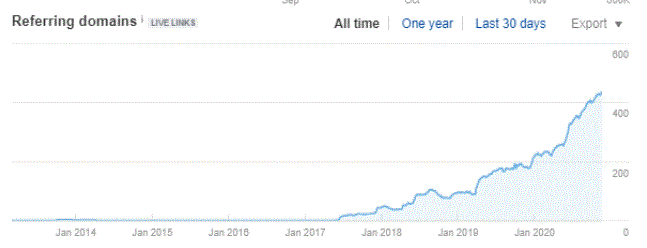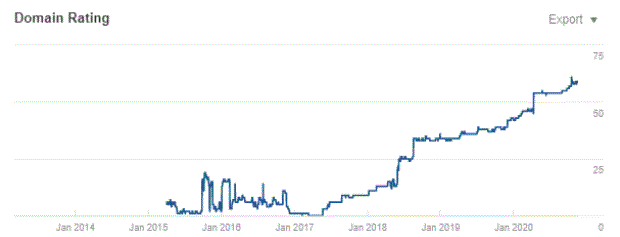No Results Found
The page you requested could not be found. Try refining your search, or use the navigation above to locate the post.
Backlinks are a vital part of how the Google algorithm determines your rankings.
These links send signals that help search engines determine how trustworthy your content is and what keywords are associated with said content. The quality of these links matters getting a large amount of low-quality foreign links is not going to help your site. Because your website is brand new, it has no “Domain Authority.” Domain Authority is how trustworthy Google views your site and is a metric developed by the SEO company Moz. It is important to note that this is a process and takes time.

The Challenge:
A top software company came to Apogee Results five years ago with a brand-new site
that had no referring domains and a domain rank of 0 (due to it being new!). Our goal
was to build high quality links that would set the foundation for future long-term success.
Objective:
Increase Domain Rank year over year and send the right keyword signals to Google.
Strategy:
The SEO team had quite the task- create quality links monthly to increase Domain
Authority over time. To accomplish this goal, the Apogee team used it’s internal process of deep keyword research to build strategy, and writing high quality content that is published around the web on high quality sites. Building intentional links helped assist with Domain Authority leading to increased rankings for keywords, increased traffic, and more conversions. Below you can see the referring domains built over time:

As you can see below, the domain rank with consistent Link-building efforts does take time to go up. It takes time for Google to recognize and value these links, and it can go up and down over a period of time before it takes off:

SEO is notorious for taking a long time (this one year case study is a prime example), but the results are undeniable, long term linkbuilding will increase Domain Authority significantly.
What about traffic? It is great to have Google rank you site higher from a Domain
Authority standpoint, but does that really bring in more traffic & potential customers?
The data says YES! See the traffic numbers over time:

Fill out the form below to request a complementary evaluation of your digital marketing today.

I have spent the last several years advising perhaps a thousand entrepreneurs and corporate executives on how to develop their strategies and grow their business. These enterprises include every size from startups to billion-dollar corporations, every industry from high tech to restaurants, and every location from small town Texas to Malaysia and Mexico. One of the most common things blocking people’s strategic thinking is a failure to understand their own industry and those industries and companies that bear on the enterprise’s success.
There is no way one can understand the potential of their company or plot a great strategy without understanding their industry and how their company fits in.
The first step is to understand the big picture. Start with these questions:
The second step is to understand the industry structure:

Third, learn everything you can about the major participants at each level of the system:
Fourth, go deep on each company you discover:

These steps may sound like a lot of work, but the future of your company and the intelligence of your strategies and tactics depend on “knowing the game.” These steps should not be delegated: even if you have help doing the digging (hire a firm like Bizologie or make the process a student project), leadership must internalize what is learned. No one other than top management can imagine (and execute) the possibilities for your enterprise!
 Gary Hoover is a serial entrepreneur. He and his friends founded of the first book superstore chain Bookstop (purchased by Barnes & Noble) and the business information company that became Hoovers.com (bought by Dun & Bradstreet). Gary served as the first Entrepreneur-in-Residence at the University of Texas at Austin’s McCombs School of Business. He has been a business enthusiast and historian since he began subscribing to Fortune Magazine at the age of 12, in 1963. His books, posts, and videos can be found online, especially at www.hooversworld.com. He lives in Flatonia, Texas, with his 57,000-book personal library.
Gary Hoover is a serial entrepreneur. He and his friends founded of the first book superstore chain Bookstop (purchased by Barnes & Noble) and the business information company that became Hoovers.com (bought by Dun & Bradstreet). Gary served as the first Entrepreneur-in-Residence at the University of Texas at Austin’s McCombs School of Business. He has been a business enthusiast and historian since he began subscribing to Fortune Magazine at the age of 12, in 1963. His books, posts, and videos can be found online, especially at www.hooversworld.com. He lives in Flatonia, Texas, with his 57,000-book personal library.
To get updated information about the team at Apogee Results, please follow us on your favorite social media channels.
The page you requested could not be found. Try refining your search, or use the navigation above to locate the post.
Local brick and mortar businesses can coexist with the digital marketplace as long as they invest in their online real estate. When done well, a strong local SEO strategy will generate traffic and help your business compete with big brands. The easier it is for customers to find local businesses via search, maps, videos or social media, the greater their chances of increasing valuable foot traffic. Here’s how Jesse Mcdonald, a fellow SEO strategist from Austin, uses his years of creating delightful user experiences to help local businesses function well on-line and off.
Most of the following strategies stem from Jesse’s golden rule: be smart. Take time to think about your own desired experience. He emphasizes the importance of creating the most efficient search experience possible.
Which Aspects Are Often Overlooked?
Page speed and mobile-friendliness are qualities that shouldn’t be taken for granted, even with local businesses. Most of Google’s ranking algorithm is mostly unknown, however they have publicly confirmed the significance of page speed. A surefire way to boost your sites speed is to use plugins sparingly. Although it can be tempting to overload a page with plugins as a way to minimize the amount of code writing needed, they will end up adding extra bulk and cluttering the page with unnecessary javascript and CSS. Jesse notes that even a couple seconds can significantly drop the site in rank. Therefore he encourages running a speed test before and after making changes so that you have a benchmark.
How Can Schema Help?
Whenever Google discusses organic search, schema markup is always a part of the conversation. Structured data is a way for businesses to describe to Google what the important information is on their webpages. Using structured data is almost like talking to Google, telling it what your site is really about. JSON-LD is the language or code that search engines understand and schema is the best tool to create the markup you need for your pages. Managing how the data is structured and how the search engines understand it, restores your control over your brand.
Schema markup also produces rich search results that give users more accurate information about the website and more relevant answers to their queries. It is the best way to give the search engines direct knowledge about what you are offering them, showing them good reasons to rank you. Even before the link is clicked a customer searching for your products or services has a lot of clear and important information in front of them.
Constant updates and additions are added to schema to continually improve it. For example, there is a schema markup called Speakable for voice snippets which allows you to highlight lines of text that you want verbally readout. This text-to-speech conversion helps ensure your site complies, is user-friendly for the visually impaired and clarifies content for voice queries when using Siri, Cortana, or Alexa, etc.
For those who need help getting started, Joe Hall’s JSON-LD Schema Generator is a tool that can be used to quickly create the correct JSON-LD for any page on your site. Spammy schema not only fails to serve its purpose but can also flag manual fees. Jesse strongly recommends using the Google Structured Data Testing Tool to make sure it validates before going live so you know you’re getting it right.
Google My Business
This is a highly underutilized SEO advantage that a lot of local businesses don’t use or know even exists, but it’s one of the most important elements. Once listed with Google My Business, your business will be much easier for people to discover as it will show up as a verified business on Google Maps as well as the sidebar on the Google search page.
Just getting the NAP (Jesse’s shorthand for Name, Address, and Phone Number) marked up is a simple start and sends a huge signal to Google. Also including any active social platforms can help build relevance. Your Google My Business listings will provide your contact information to potential customers so it’s crucial that you ensure these details are up to date, consistent and error-free. Mistakes and mixed messages can confuse potential customers and result in a drop in ranking.
Including honest reviews in those rich text ads is another way to attract customers. While having Google, Bing, and Yelp reviews is helpful, Jesse advises creators not to underestimate the power of having reviews posted directly on your site. He cautions against marking up reviews from third-party sites, as it can be flagged and your site may be penalized. Allowing users to leave genuine reviews directly on the site allows you to put markup code on it and provides a great opportunity to stand out and improve local presence. Nobody is perfect, and only showing 5-star reviews isn’t always the best way to present a successful business. Displaying an honest consumer perspective is an opportunity to show potential customers that your business makes an effort to provide the best services possible and is open to growth and self-improvement.
Your customers are living in a digital world and are looking for you and your products. If you can outshine the competition the above tips will get you on the right path to success. If you would like to learn how the marketing team at Apogee Results can help you implement these strategies and more, please visit our Search Engine Optimization page or fill out the contact form here in the blog post.
Jesse McDonald is a global SEO strategist for IBM. The personal insights and important tips in this piece were part of a podcast interview with hosts Michelle Stinson Ross and Robert O’Haver on Search Talk Live. A local SEO specialist and experienced conference speaker, Jesse began his career focusing on SEO at several smaller agencies before branching into global e-commerce, eventually leading him to his current position at IBM.
 Lena Schulz is Apogee’s newest Social Media and PPC Full Time Intern. She graduated from Loyola University Maryland with a degree in International Studies and Marketing. She assists our team by providing clients with community social media management, PPC strategy and content writing. In her free time, she loves to work on graphic design, discover new foods and relax by the nearest body of water.
Lena Schulz is Apogee’s newest Social Media and PPC Full Time Intern. She graduated from Loyola University Maryland with a degree in International Studies and Marketing. She assists our team by providing clients with community social media management, PPC strategy and content writing. In her free time, she loves to work on graphic design, discover new foods and relax by the nearest body of water.
To get updated information about the team at Apogee Results, please follow us on your favorite social media channels.
by Chris Glazer
When I was in business school, I was introduced to many impactful minds of past and present business leaders. Somehow, the quote that stuck the most is from perhaps the oldest modern business leader, Peter Drucker, known as the father of modern management.
He wrote,
“Because the purpose of business is to create a customer, the business enterprise has two–and only two–basic functions: marketing and innovation. Marketing and innovation produce results; all the rest are costs. Marketing is the distinguishing, unique function of the business.” Peter Drucker, Father of Modern Management
This insight has stuck with me for the past several years, in part, because it is quite simple, but also because it rings true with every company I have encountered. Working in a marketing agency, I come across countless organizations- from B2B technology firms to large e-commerce companies to small local service companies. These businesses differ vastly in specialization, focusing on selling their SaaS product, golf clubs, air filters, pest control, or popcorn, but they all have a few things in common: they have a vision for what makes them different from their competition and they have innovation that makes them special. However, they also typically struggle to properly market themselves in the vast digital landscape we find ourselves in. Marketing has evolved significantly over the past few decades, and there are now so many ways a business needs to market themselves that it can become dizzying.
The difference between a great idea and a great business is marketing. It is said that Thomas Edison, who invented some of the most important inventions in the 20th century, was a terrible businessman and never made much money from his inventions. In this day in age, the struggle for businesses remains the same: how do we market ourselves correctly and create loyal customers?
How can you push the envelope in 2020? Focus on marketing. Read on as we explore.
Every business needs marketing, but with so many techniques and channels, where should the focus be? The quick answer is that it depends on your business, as there is no one channel or technique to successfully market your business. You must analyze which channels are most profitable for you and test different marketing channels. If you are not engaging in digital marketing online, your first goal for 2020 should be building a digital marketing plan- because your competition most certainly is. For some companies, the tried and true mailer is still the most important marketing technique. Likewise, other companies successfully use cold calling to reach its customers. However, almost all companies can benefit from digital marketing online, but don’t take my word for it- just see what your competition is doing. The following are three of the most important channels for online marketing that all companies should be testing, analyzing the ROI for, and building new strategies for in 2020.
Social media can be an important part of your digital marketing mix, but don’t expect your organic social to do much for you. Most companies need to make sure their profiles are built out and appear professional on major social media sites (Facebook, LinkedIn, Twitter, Instagram), but unless you have already built up a giant following, spending too much time on organic social can be a waste of time and money. To reach the audience you need on social media, expect to spend money on paid social. You also need to pay attention to which social media channels you are investing in and test to figure out where you get the most engagement for your money. This helps ensure you are reaching the audience you need to reach. Social media should also be thought of as top-of-funnel, meaning building awareness to your brand. Social media typically does not yield strong conversion rates, but some business types are able to do it quite successfully.
Pay to play in the spaces that matter most to potential customers. Social media is at its most powerful at the brand level, introducing new audiences across Facebook, Twitter, Instagram, Pinterest, LinkedIn, Snapchat, and TikTok to the products and services provided by your business. This introduction cannot be made without using the advertising systems in these channels.
To acquire new audiences for your brand, craft audience targeting around your topics of expertise and their interest in those topics. Serve those audiences with short, easy to consume video content formatted for mobile. And then retarget engaged users to guide them along the customer journey.
Using social media advertising in this way creates highly qualified audiences at a much lower cost for audience acquisition than depending on paid search alone. Michelle Stinson Ross, Senior Social Media Strategist
Paid search can be a highly effective way to reach your customers. In 2020, most people use Google (and other search engines) to find what they are looking for. If you are selling a product, you need to be on Google paid search, Google Shopping, and be remarketing with display ads. Be careful of overusing display, however, as we can all get sucked into the pure volume of traffic without doing a full ROI analysis. Display is cheap, but the traffic is typically poor quality. Within paid search, shopping, and display, there are many different targeting tactics and campaign types. Make sure you are endlessly testing and analyzing your results to maintain as high an ROI as possible.
For companies that are not directly selling a product online, or who are selling a low-cost product, paid search should be used more sparingly. It is increasingly expensive, particularly in competitive spaces, so make sure you are running a professionally managed, granular account. For some companies, paid search will not yield the results they are looking for. It should always be tested as a channel to possibly break into, but if you aren’t doing paid search already, make sure the person who is running it knows what they are doing and that you have a significant budget (and patience) for such a test.
Many advertisers we see do not have extensive extension options built into their ads. Having multiple extensions at the account and/or campaign level can really bolster up an ad. The extensions we most often see in accounts are callout extensions since they require the least information/time. Having sitelink extensions helps lead the customer to a more specific page so they are more likely to spend time/convert. Call extensions are great if you have a sales team built out and are able to direct calls efficiently. Review and location extensions can especially help when a customer may be in a hurry to find an item or fulfill a need.
Going into 2020, customers will continue to want efficiency in their quest for goods and services. Having extensions helps you by bolstering your ads in size and accuracy but also helps the customer see when you offer exactly what they want. Lena Sidhu, Senior Paid Search Strategist
SEO in 2020
Search engine optimization is a marketing technique that is crucial to most companies, and yet, it is typically the most neglected channel. Why is this? The answer is two-fold: it is difficult to understand, and it takes time to see results. Companies do not want to be patient, with board members and CEO’s demanding instant results, but strong SEO work often yields the highest ROI over time. If you don’t have a specific SEO strategy in place, 2020 is the perfect time to start. SEO includes three main tactics: technical SEO, on-page or content SEO, and off-page SEO. All are important.
All three tactics are important, but you need to make sure that the person or agency who runs your SEO is competent enough to keep up with Google’s constantly changing search algorithm.
Companies need to spend more time talking about what they do in natural language.
We can’t rely on keywords as a data source alone and need to focus on true questions people have about products/services that the company offers. Search is changing and queries need to be answered in plain english, hindi, spanish or what have you.
According to Google’s recent update “small tables end” = “small end tables” = “good end tables for my living room” this is not new per say, but Google has announced they’ve gotten better at assessing content for natural language and human readability. We have seen sites that do this well gain more traction and sites that do this poorly start to lose rankings in recent months. Brent Schiffman, Senior Search Engine Optimization Strategist
Most of All, Don’t Give Up
Marketing can be frustrating. You can try multiple practitioners, agencies, and tactics but still not get the results you need. It is important to remember, however, what Peter Drucker said. All too often, I see when a company begins to struggle, the first budget that is slashed is marketing. The instinct makes sense from a human psychological standpoint, but ultimately, it is the opposite move to get your company back on track.
Our capabilities in digital marketing include organic and paid search, local SEO, social media marketing, content strategy and development, and influencer marketing. We have proven results over 20 years across a broad range of businesses. Our difference is in our proven capabilities, industry thought leadership and client focus.
We know the way is not always clear. Don’t brave the digital marketing world by yourself. Connect with us and let us join you in developing your digital footprint.
 Chris Glazer is the Senior Director of Client Operations at Apogee Results. He helps clients grow. His responsibilities include sales, managing and growing high-priority clients, and acting as an operational leader for the company. He strives to look at the whole picture of a business and use marketing to help companies achieve their goals.
Chris Glazer is the Senior Director of Client Operations at Apogee Results. He helps clients grow. His responsibilities include sales, managing and growing high-priority clients, and acting as an operational leader for the company. He strives to look at the whole picture of a business and use marketing to help companies achieve their goals.
To get updated information about the team at Apogee Results, please follow us on your favorite social media channels.
What Does Influencer Marketing Mean?
Let’s break it down. First and foremost the average person doesn’t quite have an accurate grasp on what influencer marketing actually means. Any layperson’s first instinct might be to assume that the label is reserved for models on Instagram pushing lifestyle products. However, the concept is about as old as marketing gets, predating Instagram by about 300 years. It is defined as a form of marketing that involves endorsements from people and organizations, usually possessing a high level of knowledge or social influence in their respective fields. At its core, anyone who has cultivated an audience that is relevant to your business could be an influencer for you. Be it a celebrity, a thought leader on Twitter, a journalist, a podcast or even on a smaller scale, micro audiences stemming from organic user-generated content. Even link building can act as PR and is also a part of influencer marketing. Influencers can be anyone, anywhere. Within any industry, there are influential people: it’s up to you to find them.
How Can I Make It Work for Me?
With each field best practices differ so it can be hard to generalize which channels are most effective to push messages through. Michelle recommends for most starting with building up representation on social platforms and then branching out to blogs and long-form content when applicable. As an example, a haircare brand looking to boost shampoo sales would want to pair with people representing their target demographic on Instagram, for example. This is a perfect outlet for a brand wanting to showcase how its users look and feel. With this specific brand, unusual scientific terms and differences in the product required some customer education, which is where blogs and educational articles came into play.
For Influencers
From the influencer side, Michelle says there is still a need for maturity and professionalism that still isn’t quite present in the influencer space. As this channel of marketing matures, influencers need to understand they can no longer craft their rate sheet based solely on how big their audience is and how engaged the followers are. That criteria is the qualifier that brands use to prioritize their choice of influencers. Expect for brands to ask for specific deliverables as part of their contract negotiations.
Influencer deliverables
For Brands
Don’t get caught up on attempting to look at Cost Per Acquisition (CPA) when it comes to working with influencers, mainly because its difficult to put a direct price point on posts. Overall, social media is very top-of-the-funnel and its main function is to drive awareness. Especially on Instagram, the average user does not necessarily click and buy anything immediately. Efficacy can best be measured by increased brand awareness and audience acquisition, not simply direct sales. It’s more relevant to focus on how much traffic has been driven to specific landing pages, how many people have filled out a form, how big the email list has grown, and how big the cookie and retargeting pools have gotten as a result of working with an influencer.
Finding the Perfect Fit
The best way to find the right person or group to represent your brand is to full-on scout out potential as if they were a pro athlete. Dive deep, stalk them, and fully assess the pros and cons of partnering with them. Take note on follower genuineness: are the accounts engaging with real accounts or heavily overrun with bots? It’s also a two-way relationship if you get a rejection it doesn’t necessarily mean it wasn’t a good fit, it may have just been bad timing. Even if you find the perfect arrangement, you need to be prepared in advance for the reputation management aspect of the partnership as you have put a part of your brand identity in the hands of someone else. There is always a risk because you and your brand identity will be linked to that person’s decisions, and that can always go one of two ways in the future. It’s also a two-way relationship. If you get a rejection it doesn’t necessarily mean it wasn’t a good fit it may have just been a bad time. In the great search planning is everything. Marketing should begin on day one. Seek out people who align with the identity you want to represent and ask yourself what are your business goals and where are you customers.
If you would like to learn more about how Apogee Results can help you with developing an influencer marketing plan. Request your Influencer Contract Template, fill out the contact form here in the blog post, or get in touch with Michelle Stinson Ross directly via LinkedIn
 Lena Schulz is Apogee’s newest Social Media and PPC Full Time Intern. She graduated from Loyola University Maryland with a degree in International Studies and Marketing. She assists our team by providing clients with community social media management, PPC strategy and content writing. In her free time, she loves to work on graphic design, discover new foods and relax by the nearest body of water.
Lena Schulz is Apogee’s newest Social Media and PPC Full Time Intern. She graduated from Loyola University Maryland with a degree in International Studies and Marketing. She assists our team by providing clients with community social media management, PPC strategy and content writing. In her free time, she loves to work on graphic design, discover new foods and relax by the nearest body of water.
To get updated information about the team at Apogee Results, please follow us on your favorite social media channels.